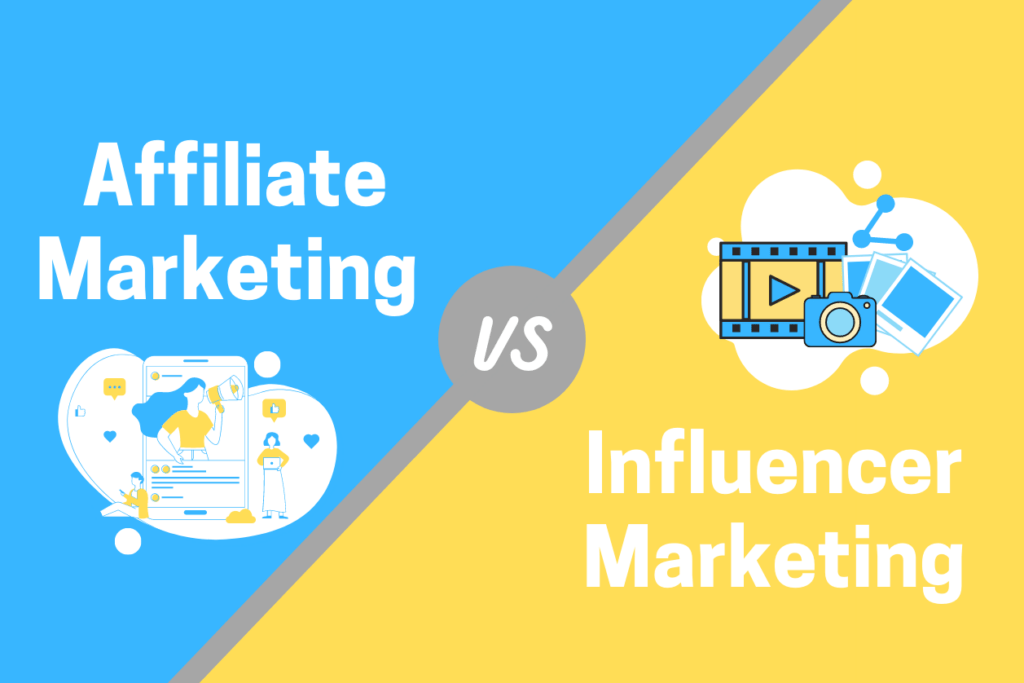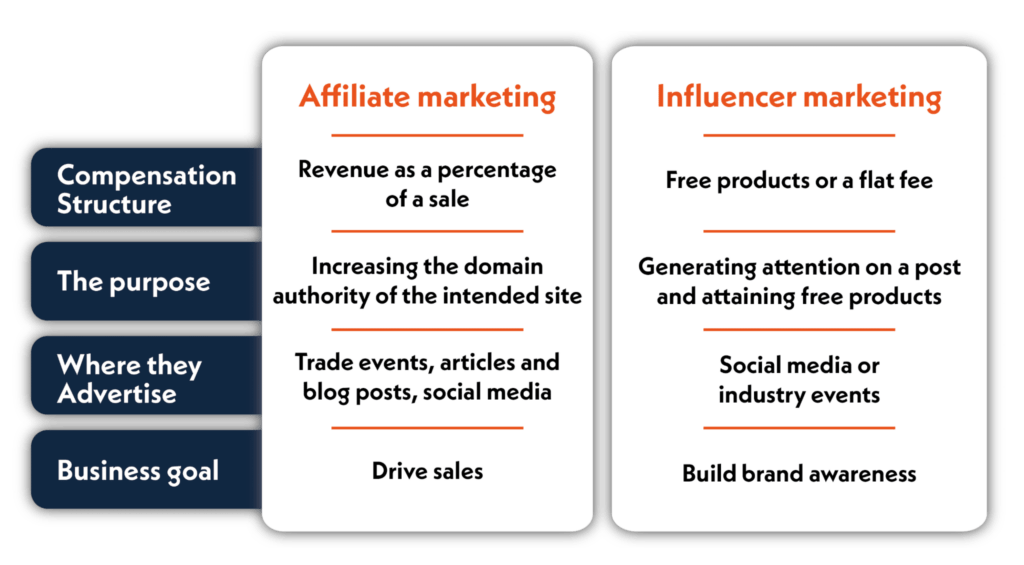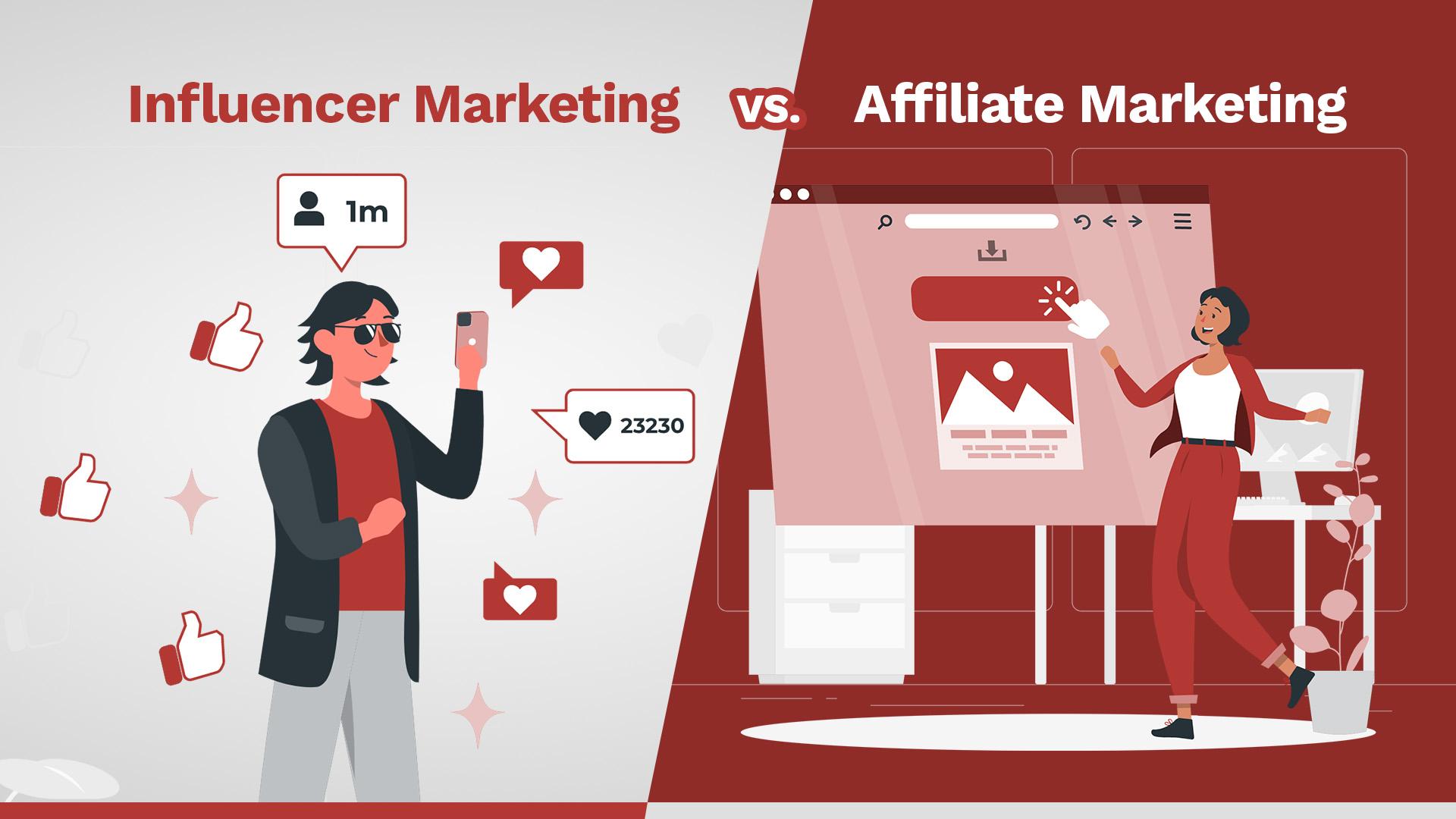In today’s digital landscape, brands have a plethora of marketing strategies at their disposal to promote their products or services and engage with their target audience. Two popular strategies that have gained significant traction in recent years are influencer marketing and affiliate marketing. While both approaches harness the power of digital platforms and influential individuals, they differ in their execution, goals, and the benefits they offer to businesses. Explore the world of influencer marketing VS affiliate marketing, their unique characteristics and how businesses can leverage each strategy to their advantage.
Influencer VS Affiliate Marketing
Influencer marketing and affiliate marketing are two popular strategies used in digital marketing to promote products or services and drive customer engagement and sales. While they share some similarities, there are distinct differences between the two.
Influencer Marketing:
In influencer marketing, brands collaborate with influential individuals or social media personalities, known as influencers, to endorse or promote their products or services. Influencers typically have a substantial following on platforms like Instagram, YouTube, TikTok, or blogs, and they leverage their influence and credibility to create content that highlights the brand’s offerings. They may feature the product in a post, video, story, or review, often including a call-to-action for their followers to try or purchase the product. Influencer marketing focuses on utilizing the influencer’s reach, authority, and authenticity to connect with their audience and generate interest in the brand.
Key points about influencer marketing:
- Collaborates with influencers who have a significant following and influence in a specific niche or industry.
- Relies on the influencer’s credibility and ability to engage their audience.
- Content creation is driven by the influencer’s creativity and style.
- Payment to influencers may involve a fixed fee, free products, or a combination.
- Success is measured by metrics like reach, engagement, impressions, and brand mentions.
Affiliate Marketing:
Affiliate marketing is a performance-based marketing model where individuals, known as affiliates or publishers, promote a product or service and earn a commission for each sale or action generated through their unique affiliate link. Affiliates can be bloggers, content creators, website owners, or anyone with an online presence. They promote the product through various channels such as blog posts, social media, email marketing, or dedicated landing pages. When a user clicks on the affiliate’s link, they are redirected to the brand’s website, and if a purchase or desired action occurs, the affiliate earns a commission.
Key points about affiliate marketing:
- Affiliates promote products or services through unique affiliate links.
- Commissions are earned based on the desired actions, such as sales, leads, or clicks.
- Affiliates have more control over the content they create and how they promote the product.
- Payment to affiliates is typically commission-based, often a percentage of the sale.
- Success is measured by metrics like conversions, clicks, and revenue generated.
While influencer marketing focuses on leveraging an influencer’s popularity and trust among their audience, affiliate marketing is more performance-driven, rewarding affiliates based on the actions they drive. Both strategies can be effective for brands to expand their reach, drive sales, and increase brand awareness, but the approach and execution may vary. Many brands often incorporate both influencer marketing and affiliate marketing into their overall marketing strategies for a comprehensive and diversified approach.
The Purpose


Both influencer and affiliate marketing are closely connected to e-commerce. They are commonly used strategies in the e-commerce industry to promote products, drive online sales, and increase brand visibility.
Influencer marketing involves collaborating with influencers, who often have a strong presence on social media platforms or other online channels. These influencers can effectively showcase products or services to their followers, generating interest and driving traffic to e-commerce websites. Partnering with influencers who have a relevant audience, brands can tap into a targeted customer base and increase the likelihood of conversions and sales.
Affiliate marketing, too, plays a significant role in e-commerce. It involves partnering with affiliates who promote products or services through their online platforms and earn a commission for each sale or action they generate. Affiliates often leverage various channels like blogs, social media, or dedicated landing pages to drive traffic and direct potential customers to e-commerce websites. This performance-based marketing model allows e-commerce businesses to expand their reach, tap into different audiences, and increase revenue through a network of affiliates.
How Influencer Marketing and Affiliate Marketing Work?


While similar in the nature, how the two types work differ significantly. Especially when it comes to the costs.
Influencer Marketing:
Collaboration: A brand identifies an influencer whose audience aligns with their target market and initiates a collaboration. They negotiate terms, including compensation, deliverables, and campaign objectives.
- Example: A fitness apparel brand partners with a popular fitness influencer to promote their new activewear line. The influencer creates content showcasing the brand’s products and shares it with their followers on Instagram.
Content Creation: The influencer creates engaging and authentic content that incorporates the brand’s products or services. This content could be in the form of social media posts, videos, blog articles, or live streams.
- Example: A travel company collaborates with a travel blogger who documents their experience using the company’s services, sharing stunning visuals, personal stories, and travel tips across their blog and social media platforms.
Promotion and Engagement: The influencer shares the content with their followers, highlighting the brand’s offerings and encouraging them to engage or take specific actions (such as making a purchase or visiting the brand’s website).
- Example: A beauty brand partners with a makeup tutorial YouTuber who creates a video showcasing a step-by-step makeup look using the brand’s products. The influencer includes links to the products in the video description, prompting viewers to shop for the items.
Measurement and Analysis: Brands track the performance of the influencer marketing campaign using metrics such as reach, engagement, impressions, conversions, and brand mentions. This data helps evaluate the campaign’s success and ROI.
- Example: An electronics company assesses the impact of their influencer campaign by monitoring the increase in website traffic, the number of click-throughs to product pages, and the sales generated during the campaign period.
Affiliate Marketing:
Affiliate Recruitment: Brands establish an affiliate program and invite individuals or organizations to join as affiliates. Affiliates sign up and receive unique affiliate links or promo codes to track their referrals and earn commissions.
- Example: An online bookstore creates an affiliate program and invites book bloggers, book review websites, and book clubs to join as affiliates.
Promotion and Referral: Affiliates promote the brand’s products or services through various channels, incorporating their affiliate links or promo codes. When users click on the links or use the codes to make purchases, the affiliates earn a commission.
- Example: A fashion retailer’s affiliate, a fashion blogger, writes a blog post reviewing the latest collection and includes affiliate links to the specific items. Readers who click on the links and make purchases earn the blogger a commission.
Conversion Tracking and Commissions: Brands utilize tracking systems to monitor conversions and attribute them to specific affiliates. Affiliates receive commissions based on the agreed-upon terms, such as a percentage of each sale or a fixed amount per lead.
- Example: A software company tracks the number of software subscriptions generated through affiliate referrals and pays the affiliates a predetermined commission for each successful subscription.
Performance Analysis: Brands analyze the performance of their affiliate marketing efforts by examining metrics like conversions, clicks, revenue generated, and the ROI of each affiliate. This data helps optimize the program and identify top-performing affiliates.
- Example: An e-commerce retailer evaluates the conversion rates and revenue generated by different affiliates and provides performance-based incentives or rewards to their most successful partners.
Cost


The costs associated with affiliate marketing and influencer marketing can vary based on several factors, including the scope of the campaign, the reach and influence of the affiliates or influencers, and the negotiated terms between the brand and the partners involved. Here’s a breakdown of the costs typically associated with each strategy:
Affiliate Marketing Costs:
- Commission: brands typically pay affiliates a commission for each sale, lead, or action they generate. The commission rate can vary widely, ranging from a fixed amount per sale to a percentage of the total sale value.
- Affiliate Network Fees: if a brand decides to work with an affiliate network or platform to manage their affiliate program, there may be associated fees. These fees can include setup fees, monthly platform fees, or transaction fees on each affiliate-generated sale or lead.
- Tools and Tracking Software: brands may invest in affiliate tracking software or tools to effectively monitor affiliate performance, track conversions, and manage payments. These tools may involve costs or subscription fees.
Influencer Marketing Costs:
- Payment to Influencers: brands typically compensate influencers for their collaboration and promotional efforts. The payment can be structured in various ways, such as a fixed fee, a rate per post or video, or a combination of monetary compensation and free products or services.
- Product or Service Samples: in some cases, brands provide influencers with free products or services to review or feature in their content. While this doesn’t involve direct monetary costs, it’s still a consideration for brands.
- Production and Content Creation: depending on the campaign requirements, brands may need to cover production costs associated with creating high-quality content, such as photography, videography, or graphic design.
The costs associated with both strategies can vary significantly. Influencer marketing often involves higher upfront costs due to the compensation of influencers, while affiliate marketing is more performance-based, where costs are incurred only upon successful actions or conversions. The choice between the two strategies depends on the brand’s marketing objectives, budget, and desired outcomes. Some brands even opt for a combination of both strategies to maximize their reach and impact.
Cost In Numbers:
Certainly! While specific numbers can vary widely depending on various factors, here are some general ranges and examples of costs associated with affiliate marketing and influencer marketing:
Affiliate Costs:
- Commission Rates: Affiliate commissions can range anywhere from around 5% to 50% or more of the sale value. The commission percentage is often negotiated between the brand and the affiliate, considering factors such as the product price, profit margins, and industry standards.
- Affiliate Network Fees: If a brand decides to work with an affiliate network or platform, they may incur fees. Setup fees can range from $0 to several hundred dollars, monthly platform fees can range from $20 to $200 or more, and transaction fees can be a percentage (e.g., 2%-5%) of the affiliate-generated sale or lead value.
- Tools and Tracking Software: The costs of affiliate tracking software or tools can vary based on the specific solution chosen. Some platforms offer free basic plans, while more advanced options can range from $20 to $200 per month or more.
Influencer Costs:
- Payment to Influencers: Influencer fees can range from a few hundred dollars to several thousand dollars per post or video, depending on factors such as the influencer’s reach, engagement, niche, and level of influence. Micro-influencers (with smaller followings) may charge anywhere from $100 to $1,000 per post, while macro-influencers or celebrities can command fees ranging from $1,000 to tens of thousands of dollars or more.
- Product or Service Samples: Brands may provide influencers with free products or services, which would involve the cost of producing or providing those items. The value of the samples will depend on the brand, product type, and campaign objectives.
- Production and Content Creation: Production costs can vary significantly based on the complexity and scale of the content required. Costs can range from a few hundred dollars for simpler content, such as social media posts or basic blog reviews, to several thousand dollars for high-quality videos or elaborate campaigns.
These numbers are general estimates and can vary depending on factors such as the industry, the influencers’ or affiliates’ reach and influence, the brand’s negotiation skills, and the specific goals and requirements of the campaign. Conduct thorough research, reach out to potential partners, and evaluate their specific costs and ROI potential before finalizing any agreements.
Amazon Affiliate vs. Amazon Influencer
Amazon Influencer and Amazon Affiliate are two different programs by Amazon that allow individuals to earn from promoting products on the Amazon platform. Here’s a comparison between Amazon Influencer and Amazon Affiliate:
Amazon Influencer Program:
The Amazon Influencer Program is for social media influencers who have a significant following on platforms like Instagram, YouTube, Facebook, or Twitter. It allows influencers to create a curated storefront on Amazon, featuring a selection of their recommended products.
Influencers need to apply and meet specific eligibility criteria, including having a certain number of followers and regularly posting engaging content. Amazon reviews the application and approves influencers who meet their requirements.
Once approved, influencers receive a unique URL that directs their followers to their Amazon storefront. They can curate and showcase products they recommend to their audience, and when someone makes a purchase through their storefront, the influencer earns a commission. They earn a commission on products sold through their storefront. The commission rates vary based on the product category and can range from 1% to 10% or more.
Amazon Affiliate Program:
The Amazon Affiliate Program, also known as Amazon Associates, is open to a wider range of individuals, including bloggers, website owners, content creators, and anyone with an online presence. It allows participants to earn commissions by promoting products through their unique affiliate links.
Joining the Amazon Affiliate Program involves signing up through the Amazon Associates website. Once approved, participants gain access to their affiliate dashboard, where they can generate affiliate links and track their earnings.
Affiliates can promote Amazon products through various channels like their website, blog, social media platforms, or email marketing. They use their affiliate links, which contain a unique tracking ID, to direct users to specific Amazon product pages. They earn commissions based on the referred sales made through their affiliate links. The commission rates vary depending on the product category and can range from 1% to 10% or more.
The Influencer Program is for social media influencers who want to create curated storefronts on Amazon, while the Amazon Affiliate Program is open to a broader range of individuals who can promote products using their unique affiliate links. Both programs offer the opportunity to earn commissions, but they differ in terms of the focus, application process, and product promotion.
Conclusion
Both influencer marketing and affiliate marketing are valuable strategies that businesses can leverage to achieve their marketing objectives. The choice depends on factors such as budget, brand objectives, target audience, and the desired level of control and engagement. Some businesses may find value in incorporating both strategies, utilizing influencers for brand awareness and engagement, while leveraging affiliates to drive targeted traffic and conversions. Ultimately, understanding the unique advantages and considerations of each approach can help businesses make informed decisions and maximize their marketing impact.





















Leave a Reply
View Comments